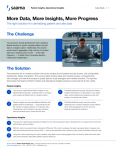Investors bet on decentralized trial technology

COVID-19 is creating a surge of interest in decentralized trials, wearable sensors and other technology. Biofourmis recently secured $100m in Series C funding, formed partnerships with numerous pharmal companies and health systems, and acquired biosensor firm Biovotion and Takeda Pharmaceuticals’ oncology-focused digital therapeutics company, Gaido Health. THREAD, another decentralized trial company, landed $50m from strategic investors.
Biofourmis CEO Kuldeep Singh Rajput said the company’s recent investment is part of a larger trend in the life-sciences industry around growth in technology that supports decentralized trials.
“COVID-19 is pushing remote monitoring and digital therapeutics to the forefront of medicine,” he said. “Our vision is to use digital medicine to empower patients, clinicians and researchers everywhere by providing software-as-a-treatment for patients with unmet clinical needs, from post-acute care to optimal medication therapy.”
Outsourcing-Pharma (OSP) spoke in detail with John Reites (JR), president of THREAD, about the progress in decentralized trial technology, evolution in industry acceptance and what the future might hold.
OSP: How have industry attitudes toward (and adoption of) decentralized trials evolved in the years leading up to the COVID-19 pandemic?
JR: Despite steady growth pre-pandemic, there was still some debate and discussion among Sponsors and CROs about the return on investment and feasibility of implementing a decentralized approach into their study designs. Over the past three years, this skepticism has decreased as evidenced by the number of decentralized studies conducted and positive results; pre-pandemic, the industry was on a trajectory towards hybrid decentralized trial designs becoming an approach that was targeted for adoption by sponsors.
OSP: Could you please tell me how the industry’s use of decentralized and hybrid trials has changed since the pandemic hit?
JR: While decentralized trials were gaining traction before the pandemic, COVID-19 brought them to the forefront of the clinical research industry. There has been a pivotal shift in demand and how studies are conducted.
Sponsors and CROs are no longer asking why they should conduct decentralized trials, but how to do it. This industry-wide move towards virtual and flexible research was inevitable, but the pandemic’s impact forced many organizations to adapt quickly and adopt innovative solutions.
OSP: How have patients’ attitudes toward decentralized trials and continuous-remote data collection shifted?
J
R: Based on the data and feedback that we have seen, patients largely enjoy the flexibilities and accessibility of our platform. They appreciate the ability to easily complete their data, get reminded about key activities and meet with their site via our unified telehealth feature; this approach puts more control and choice in the hands of the patient, which fosters engaged participation and improved data collection for our customers’ studies.
OSP: How do trial delays and interruptions, especially those caused by the pandemic, impact a trial?
JR: The pandemic has primarily disrupted the ability for studies to actively recruit participants and, in some cases, conduct on-site visits. Recruiting is typically a complex and significant phase in clinical trials already. Studies that are unable to recruit experience timeline delays.
For traditionally designed studies that had already completed enrollment and are in the maintenance phase, there’s a been a significant interruption in onsite visits and the ability to collect data.
OSP: How do technologies like remote trial monitoring and IoT help deal with such challenges?
JR: Decentralized trial services, like our THREAD Express offering that we launched in response to the pandemic, mitigate some of these recruitment challenges and consent barriers by enabling digital recruitment and consent. This offering supported our customers with a rapid process (launched in less than 10 days) to capture source data and transition onsite visits to telehealth and/or home health visits, enabling hybrid models to be put into place rapidly to support site visits that could not be conducted.
OSP: What impact is telehealth having on patient attitudes toward remote trials?
JR: Telehealth usage has been steadily on the rise for years. Many patients have come to realize the convenience and ease of a telehealth virtual visit; even for those who don’t use telehealth regularly, they are at least familiar with the concept.
This growing familiarity and comfort with booking appointments online and visiting the doctor through your phone has made the on-ramp for decentralized trial participants much less strenuous; the same can be said for providers. Clinicians have likely conducted at least some of their visits via telehealth, so there’s not a steep learning curve when we train them on the THREAD platform.
OSP: To what extent do you think the pandemic will leave the trial industry forever altered, with respect to wearables, remote monitoring and other decentralized trial aspects?
JR: The pandemic has acted as an accelerant in the industrywide shift towards flexible, hybrid clinical trial studies. We expect this accelerated growth to continue long beyond the pandemic. Innovation and adoption does not happen overnight.
Our industry has been working towards decentralized studies over the last 10 years. There’s still progress to be made across the industry, and we are committed to enabling measured adoption, scale, and sustainability of this global, patient-centric approach with our customers.



















